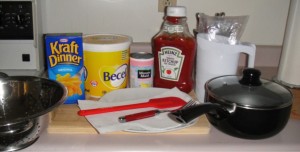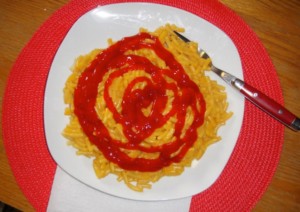My Eleven Golden Rules

In 1946, George Orwell had an article published called “A Nice Cup of Tea” in which he describes the proper way to make tea. The way in which he thoroughly and eloquently describes a process as mundane as making tea has always made me chuckle. Recently, I have been wondering whether there were any other topics in need of such profound insight. Finally it hit me. Canadians purchase 1.7 million of the seven million boxes of Kraft Dinner sold globally each week. That is a lot of KD. Arguably, it has become our de facto national food dish. However, if you pick up a box of Kraft Dinner and look on its side, you will find a few lines of sketchy instructions which give no ruling on several of the most important points. This is curious, not only because of Kraft Dinner’s iconic status in Canadian culture, but because the best manner of making and eating it can be the subject of violent disputes. With this article, I aim to put some of the most contentious points to bed. Here are my eleven rules, each one of which I regard as golden:
First of all, one should use genuine Kraft Dinner. This should go without saying. Walking through Dollarama last week I noticed a couple KD knockoffs. Law school is expensive, I get that. However, being thrifty in this particular area is an eyebrow raiser of epic proportions; especially considering how cheap it already is. People, there is but one true Kraft Dinner.
Secondly, Kraft Dinner should be made by the box. If you cannot finish a whole box in one sitting, tough; save some for later. Do not be one of those people who make only part of the box and put the rest back in the cupboard. That is just silly.
Thirdly, a rubber spatula—like the one in the picture below—should be used to stir the noodles in the boiling water and to mix in the cheese sauce. This utensil was made for KD. The rubber does not conduct heat so you will never burn yourself. Also, it is rigid but yet flexible enough not to mash the noodles when mixing in the cheese sauce. Most importantly, its rubber edges allow you to scrape the sides of the pot, ensuring effective mixing of the noodles and cheese sauce without leaving scratch marks on the pot.
Fourthly, the instructions on the box call for the noodles to be cooked for seven to eight minutes. I recommend that you err on the side of caution and cook them for eight to nine minutes. You do not want undercooked noodles. Al dente you say? More like al crape. The horror; the horror of undercooked noodles sliding down your throat, scratching the soft lining of your esophagus—is there anything as off-putting?
Stir frequency—while not overly important—is still worth noting. I stir the noodles three times. Once right after I add them to the boiling water and then every three minutes until ready. Forgetting to stir the noodles will undoubtedly lead to caked on noodles at the bottom of the pot. A good trick is to have an iTunes playlist going as they cook; every time a new song comes on, stir your noodles.
Fifthly, when making the cheese sauce, margarine is preferable to butter for two reasons. First, margarine is better for you than butter. Second—and more importantly—margarine is easier to work with. Butter is too hard and often requires an additional knife to cut it. Margarine, on the other hand, is soft out of the fridge and the rubber spatula, already in use, is perfect to transfer the margarine into the pot.
Sixthly, margarine should be added directly to the pot before the cheese powder. If you add the cheese powder first you run the risk of getting cheese powder on the rubber spatula left in the pot. This will lead to cross-contamination of your margarine container with cheese powder when you go to scoop out some margarine. The milk can be added at any point before mixing but it is best to add it either directly before or after the margarine so both can be put back into the fridge together—efficiency points bonus.
Seventhly, the addition of ketchup exponentially increases the taste of Kraft Dinner. I understand this to be a contentious issue as I have been in many passionate debates regarding the subject. However, it boggles my mind that there are people with taste buds this unrefined. Or are they just unwilling to try it? I add the ketchup on top of the KD once it is on my plate. With every bite I make sure I get a little bit of ketchup with the KD. The combined gastronomic forces of the cheese sauce and ketchup equals heaven. The recent merger of Heinz and Kraft is kismet.
Eighthly, Kraft Dinner should be served on a plate and not in a bowl. Some would chalk the bowl/plate debate up to personal preference; however, experience has taught me that the plate offers tangible benefits that the bowl simply cannot offer. Those benefits are: (1) surface area: with a plate’s expansive area, the KD is more spread out which allows for a better ketchup distribution, and ocular assessment of remaining quantity; (2) allure: there is something that tickles the hardest working sections of my intestinal tract as they appraise the challenge before them; and (3) freedom: bowls are limiting by nature. It’s like the KD is in a fortress, making it difficult to eat. The more KD that doesn’t touch the walls of a bowl, the more which makes it into your belly, and the less which finds itself permanently decorating the insides of your fine china. Furthermore, forks should always be used over spoons. This is just common sense—with a fork you can both stab and scoop the noodles.
Ninthly, in my experience the perfect drink to accompany KD is pink lemonade. Somehow its tartness is the perfect complement. In a pinch, Coke or Diet Coke would do well. However, I would steer clear of milk and all hot beverages.
Tenthly, never leave cooked KD in the pot for more than two hours—at this point the noodles begin to harden and stick to the pot making it an absolute bitch to clean. If you cannot finish the entire box, immediately scoop whatever remains into a piece of Tupperware—makes for a great late night snack. Next, before eating, soak the pot in warm water with a little dish soap. Something so quick and simple will save you from a headache later.
Lastly, making Kraft Dinner is an art and not a science. The box lists exact quantities of butter and milk to add. Don’t be a stooge by pulling out your measuring cups. It’s Kraft Dinner, not a s. 15 Charter analysis. Once you have a few boxes under your belt, you begin to develop a finely tuned sense of just how much milk and margarine to add to achieve the proper consistency of sauce.

Some people would answer that they do not like Kraft Dinner in itself—that they only make it when there is nothing else available or when they desire a cheap meal. To those misguided people I would say: really? Try making and eating Kraft Dinner by following my golden rules. It is very likely that it will alter your entire perspective on life.
There may be other controversial points that arise in connection with Kraft Dinner, but for now these points are sufficient to ensure most are on the right path. A walk down the Kraft Dinner aisle at the local supermarket reveals many Kraft Dinner varieties: Sharp Cheddar, Three Cheese, Extra Creamy, Cheese and Tomato, et cetera… Within reason, I encourage occasional diversity—even the addition of chopped-up hot dogs now and then to spice things up. However, the Original is the crème de la crème when it comes to Kraft Dinner, and it should be regarded as such. It is a quintessential Canadian classic.
For an added challenge while making your next box of KD, see if you can make it through the entire process without “losing a noodle”. It is tougher than you think.
